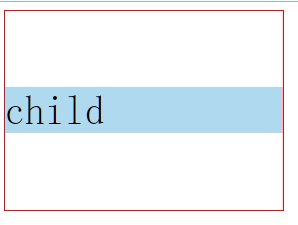水平居中
1.行内元素
父元素使用使用text-align: center;
2.宽度一定
使用margin:0 auto;
3.宽度不一定
- 将子元素改为行内元素
display: inline;在给父元素使用text-align: center; - 使用flex布局(利用了flex中的项目在主轴居中)
.parent{
display: flex;
justify-content: center;
height: 100px;
background: red;
}
.child{
margin: 0 auto;
background: blue;
}
<div class="parent">
<div class="child">这是child的div</div>
</div>
效果图:

- 使用grid布局.
下面方法是给父元素设置justify-items: center或者justify-content: center;
还有办法是给子元素设置justify-self: center;
.parent{
display: grid;
border: red 1px solid;
width: 280px;
height: 200px;
justify-items: center;
}
.child{
background-color: #afd9ee;
font-size: 40px;
}

- 使用表格布局(块元素定位方式,table的宽度默认为子元素撑开的宽度)
.parent{
height: 100px;
background: red;
}
.child{
display: table;
margin: 0 auto;
background: blue;
}
效果图:

- 使用定位布局
.parent{
position: relative;
height: 100px;
background: red;
}
.child{
position: absolute;
left: 50%;
/*或者使用margin-left: -宽/2*/
transform: translateX(-50%);
background: blue;
}
效果:

垂直居中
1. 行内元素:
line-height:高度
2. 块级元素高度一定:
- 定位实现
.parent{
position: relative;
background: #008a00;
height: 200px;
}
.child{
position: absolute;
top: 50%;
height: 100px;
margin-top: -50px; /*高的一半*/
background: yellow;
}
- 绝对定位+margin: 0
.parent{
position: relative;
background-color: purple;
width: 150px;
height: 150px;
}
.child{
position: absolute;
margin: auto;
top: 0;
bottom: 0;
width: 50px;
height: 50px;
background-color: #f0ad4e;
}

3. 高度不确定:
- 定位实现
.parent{
position: relative;
background: #008a00;
height: 200px;
}
.child{
position: absolute;
top: 50%;
transform: translateY(-50%);
background: yellow;
}
效果:

- flex布局
.parent{
display: flex;
background: #008a00;
height: 200px;
align-items: center;
}
.child{
background: yellow;
}
效果:

- 使用grid布局.
下面方法是给父元素设置align-items: center或者align-content: center;
还有办法是给子元素设置align-self: center;
.parent{
display: grid;
border: red 1px solid;
width: 280px;
height: 200px;
align-items: center;
}
.child{
background-color: #afd9ee;
font-size: 40px;
}

- table布局
表格布局vertical-align: middle;
.parent{
display: table;
background: #008a00;
height: 200px;
}
.child{
display: table-cell;
vertical-align: middle;
background: yellow;
}
效果:

水平垂直居中
1.position元素已知宽度
父元素:position: relative;
子元素:position: absolute;
将margin的margin-top设置为-高度的一半
margin-left设置为-宽度的一半
.box {
height: 500px;
width: 500px;
position: relative;
}
.content{
width: 100px;
height: 100px;
position: absolute;
top: 50%;
left: 50%;
margin: -50px 0 0 -50px;
}
2.position transform 元素未知宽度
将方法1的margin改为transform: translate(-50%,-50%);
3.flex布局
.a {
width: 600px;
height: 600px;
background-color: blue;
display: flex; //flex布局
justify-content: center; //使子元素水平居中
align-items: center; //使子元素垂直居中
}
.b {
background-color: red;
width: 200px;
height: 100px;
}
3.grid布局
下面方法是给父元素设置 justify-content: center;align-content: center;或justify-items:center;align-items:center;
还有方法可以给子元素设置 align-self: center;justify-self: center;
.parent{
display: grid;
border: red 1px solid;
width: 280px;
height: 200px;
justify-content: center;
align-content: center;
}
.child{
background-color: #afd9ee;
font-size: 40px;
}

4.table-cell布局
给元素最外层增加一个div
<div class="box">
<div class="content">
<div class="inner">
</div>
</div>
</div>
.box {
width: 300px;
height: 300px;
display: table; //表格布局
}
.content {
background-color: rgba(112,223,223, 0.5);
display: table-cell;
vertical-align: middle; //使元素垂直局中
text-align: center; //使元素水平居中
}
.inner {
background-color: #000;
display: inline-block;
width: 20%;
height: 20%;
}






















 7680
7680

 被折叠的 条评论
为什么被折叠?
被折叠的 条评论
为什么被折叠?








